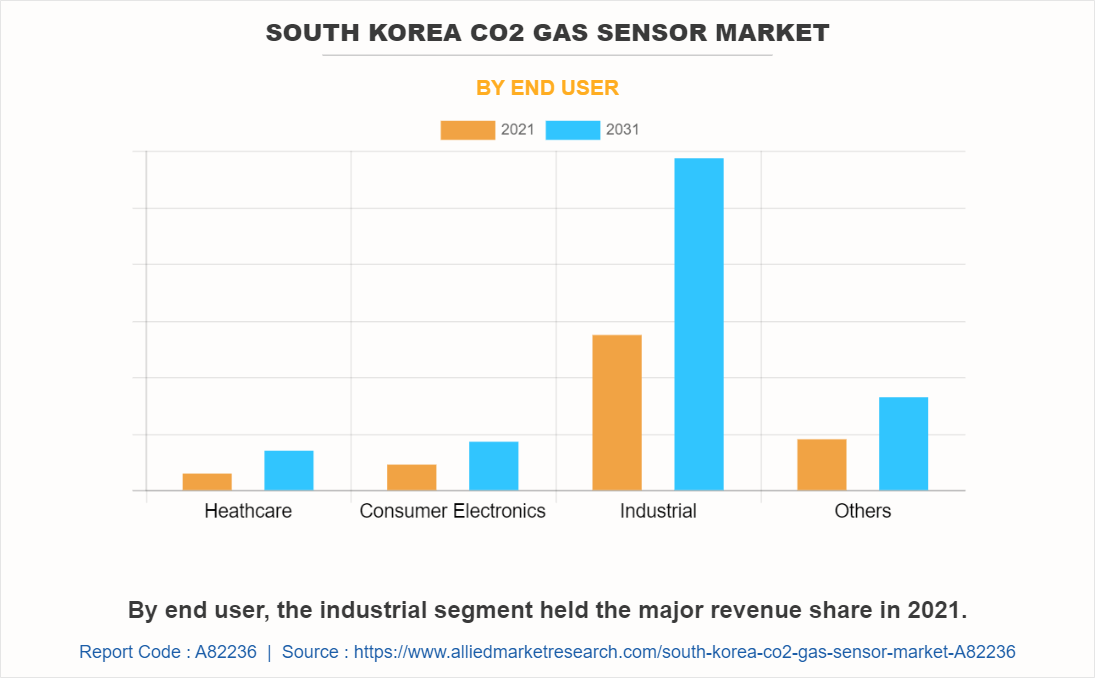The South Korea CO2 gas sensor market is anticipated to witness substantial growth during the forecast period. The major factor driving the growth of the market is to rise in awareness of environmental concerns, especially regarding monitoring and reducing carbon dioxide emissions. In addition, the increase in the demand for tracking and reducing carbon emissions has spurred demand for CO2 gas sensors across various industries, such as healthcare, consumer electronics, and industrial sectors. Furthermore, stringent government regulations pertaining to the adoption of advanced CO2 monitoring solutions are propelling the growth of the market. However, the high manufacturing costs impede market growth. In addition, pricing pressures and thinner profit margins hinder the market growth. Furthermore, the challenge of developing highly accurate and reliable sensors while keeping costs in check restrains the growth of the South Korea CO2 gas sensor market.

On the other hand, the South Korea CO2 gas sensor market is expected to offer several opportunities for new players in the market. As global environmental concerns intensify, the demand for accurate and efficient CO2 gas sensors has increased which offers new avenues for the growth of the market. In addition, advancements in technology such as the convergence of CO2 sensors with IoT and smart technology in various sectors, from healthcare and automotive to industrial automation are expected to offer lucrative opportunities for the growth of the market.
The South Korea CO2 gas sensor market is expected to witness several future trends for market expansion. Rise in the integration of CO2 sensors with IoT technology to enable real-time data monitoring and analysis, fostering sustainable practices is the current trend. In addition, miniaturization and enhanced portability will open doors to new applications, such as wearable CO2 monitors for personal health and safety. Furthermore, stringent government regulations pertaining to curbing carbon emissions will require businesses and industries to adopt advanced CO2 monitoring systems.

The South Korea CO2 gas sensor market is segmented into technology and end user. On the basis of technology, the market is classified into infrared gas sensor, photo ionization sensor, electrochemical gas sensor, thermal conductivity gas sensor, metal oxide based gas sensor, catalytic gas sensor and others. By end user, the market is categorized into healthcare, consumer electronics, industrial and others. Different technologies are experiencing varying levels of adoption across industries. For instance, healthcare and industrial sectors are increasingly relying on electrochemical gas sensors due to their high accuracy. Consumer electronics, on the other hand, are witnessing a surge in demand for compact, low-power infrared gas sensors. Navigating these intricate segmental dynamics will be crucial for market participants.

Qualitative insights represent about remarkable developments in the South Korea CO2 gas sensor market. These insights encompass new product development, research and development efforts, consumer/end-user perceptions, and pricing strategies. Companies are focusing on new product development and investing heavily in R&D to develop sensors that are energy-efficient, cost-effective, and offer precise measurements Companies are focusing on collaborations, combining expertise from electronics, material science, and data analytics to provide sensors that are sensitive, robust, and capable of functioning under diverse conditions. End-users across various sectors are increasingly perceiving CO2 gas sensors as indispensable tools for ensuring safety, health, and environmental compliance. Companies are adopting pricing strategies that balance cost-effectiveness with value addition. The ability to offer competitive prices while maintaining product quality and accuracy will be a key determinant of market success.
Porter’s five forces analysis is a model, that analyzes the competitive scenario of the industry and the role of each stakeholder. The five forces include the bargaining power of buyers, the bargaining power of suppliers, the threat of new entrants, the threat of substitutes, and the level of competitive rivalry. The bargaining power of suppliers of critical components is high due to the advanced sensor materials and cutting-edge electronics. The market's burstiness often means that suppliers must be flexible and innovative to fulfill the ever-evolving demands of manufacturers. The bargaining power of buyers, particularly in competitive markets, have the upper hand due to a wide variety of options to choose from and are often able to demand competitive pricing and customized solutions. The threat of the entrants is the complex and technology-driven nature of the market which poses a barrier to entry for new players. The need for substantial R&D investment, regulatory compliance, and intense competition makes it challenging for newcomers to gain a foothold. The threat of substitutes is low, as CO2 gas sensors remain the primary choice for accurate CO2 monitoring. However, the market's dynamism is leading to the development of more efficient and cost-effective sensors. The level of competitive rivalry among competitors is fierce, driven by South Korea's reputation for technological innovation. Established companies and startups are continually innovating, pricing competitively, and exploring new market niches.
A SWOT analysis provides an overview of the South Korea CO2 gas sensor market. It includes its internal strength, weakness, opportunities, and threats. The strength of South Korea CO2 gas sensor market boasts a strong foundation in technological innovation and an extensive network of R&D institutions. Established players have a wealth of experience and brand recognition, contributing to market stability. The weakness includes the high manufacturing costs and the need for continual innovation. Smaller companies may struggle to keep up with the pace of technological advancement. The opportunities include rise in awareness of environmental concerns and the need for stringent CO2 monitoring to create fertile ground for market growth. The integration of CO2 sensors with IoT and smart technologies opens new horizons for applications. The threats include fierce competition, especially from global players, who may leverage economies of scale and established supply chains. In addition, regulatory changes can be both an opportunity and a threat, depending on a company's ability to adapt. The major players operating in the South Korea CO2 gas sensor market are Figaro Engineering Inc., Sensirion AG, Siemens AG, Amphenol Corporation, AlphaSense, Gas Sensing Solutions Ltd., SenseAir AB, Vaisala Corporation, Honeywell International Inc., and Nissha Co., Ltd.
Key Benefits For Stakeholders
- Enable informed decision-making process and offer market analysis based on current market situation and estimated future trends.
- Analyze the key strategies adopted by major market players in South Korea CO2 gas sensor market.
- Assess and rank the top factors that are expected to affect the growth of South Korea CO2 gas sensor market.
- Top Player positioning provides a clear understanding of the present position of market players.
- Detailed analysis of the South Korea CO2 gas sensor market segmentation assists to determine the prevailing market opportunities.
- Identify key investment pockets for various offerings in the market.
South Korea CO2 Gas Sensor Market Report Highlights
| Aspects | Details |
| Forecast period | 2021 - 2031 |
| Report Pages | 86 |
| By Technology |
|
| By End User |
|
| Key Market Players | Nissha Co., Ltd., Gas Sensing Solutions Ltd., SenseAir AB, Honeywell International Inc., Sensirion AG, Vaisala Corporation, Siemens AG, Figaro Engineering Inc., Amphenol Corporation, AlphaSense |
The South Korea CO2 Gas Sensor Market is estimated to reach $45.3 million by 2031
Figaro Engineering Inc., Sensirion AG, Siemens AG, Amphenol Corporation, AlphaSense, Gas Sensing Solutions Ltd., SenseAir AB, Vaisala Corporation, Honeywell International Inc., and Nissha Co., Ltd. are the leading players in South Korea CO2 Gas Sensor Market
Figaro Engineering Inc., Sensirion AG, Siemens AG, Amphenol Corporation, AlphaSense, Gas Sensing Solutions Ltd., SenseAir AB, Vaisala Corporation, Honeywell International Inc., and Nissha Co., Ltd. are the leading players in South Korea CO2 Gas Sensor Market
1. Enable informed decision-making process and offer market analysis based on current market situation and estimated future trends.
2. Analyze the key strategies adopted by major market players in south korea co2 gas sensor market.
3. Assess and rank the top factors that are expected to affect the growth of south korea co2 gas sensor market.
4. Top Player positioning provides a clear understanding of the present position of market players.
5. Detailed analysis of the south korea co2 gas sensor market segmentation assists to determine the prevailing market opportunities.
6. Identify key investment pockets for various offerings in the market.
1. Enable informed decision-making process and offer market analysis based on current market situation and estimated future trends.
2. Analyze the key strategies adopted by major market players in south korea co2 gas sensor market.
3. Assess and rank the top factors that are expected to affect the growth of south korea co2 gas sensor market.
4. Top Player positioning provides a clear understanding of the present position of market players.
5. Detailed analysis of the south korea co2 gas sensor market segmentation assists to determine the prevailing market opportunities.
6. Identify key investment pockets for various offerings in the market.
South Korea CO2 Gas Sensor Market is classified as by technology, by end user
South Korea CO2 Gas Sensor Market is classified as by technology, by end user
Loading Table Of Content...
Loading Research Methodology...



